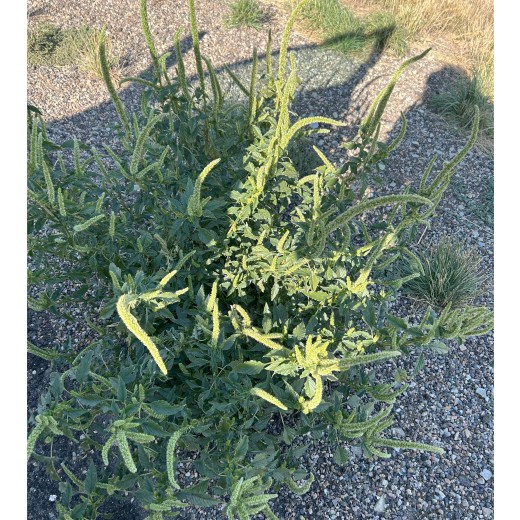Palmer amaranth (Amaranthus palmeri) was confirmed for the first time in Hill County, Montana in August 2025. This is the fourth confirmed occurrence of this weed in Montana. Be on the lookout for this species and its close relative waterhemp (Amaranthus tuberculatus). Given the abundant summer precipitation, we have more warm season weedy plants than usual.
Palmer Amaranth and Waterhemp in Montana
Palmer amaranth and waterhemp are both pigweed species that have limited known distribution in Montana. Both species have developed genotypes resistant to most herbicide modes of action. If they become established, these two species will have a large economic impact on Montana agriculture. Both weeds have the potential to establish in warm season crops such as corn and millet, and also irrigated sugarbeets, cereals, and pulse crops.
In August 2025 one Palmer amaranth plant was found growing near a grain bin in Hill County. The plant was removed from the site and further monitoring of the site is planned. This detection follows one in Carter County in 2024, and detection in 2023 in Daniels and Toole Counties. To date fewer than ten Palmer amaranth plants have been found in Montana, and all were removed from their sites prior to seed production. This plant is not known to be established in Montana.
Two waterhemp populations have also been found in eastern Montana in recent years. One is established in Roosevelt County that was first detected in 2020, and a few plants were found in a sugarbeet field in Prairie County in 2021.
Now is a good time of year to scout fields for Palmer amaranth and waterhemp because these warm season pigweeds are best identified when flowering. Special attention should be given to scouting warm season forages and irrigated fields. Look for large pigweeds with long, thin inflorescences compared with more common relatives like redroot pigweed.
Early detection and rapid response are critical to contain these weeds and prevent populations from establishing, so learn to identify them, take action to manage and control spread as needed, and learn to recognize potential vectors. Identification can be difficult, but the MontGuides and resources linked below can help identify the different pigweeds.
Contact your local Extension office or agronomist if you suspect you have found either of these species or if you have questions about pigweed identification.
Resources for Identification and Management
- Montana Department of AgricultureEarly detection Rapid Response Palmer Amaranth Page
- Palmer Amaranth MontGuide
- Waterhemp MontGuide
- NDSU Palmer Amaranth Webpage
Contact Tim Seipel, Extension Cropland Weed Specialist (timothy.seipel@montana.edu)
Noelle Orloff, Schutter Diagnostic Lab (noelleorloff@montana.edu)
###
MSU Extension


